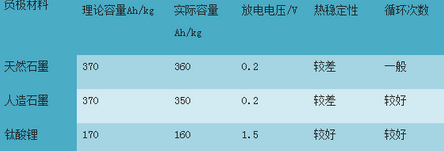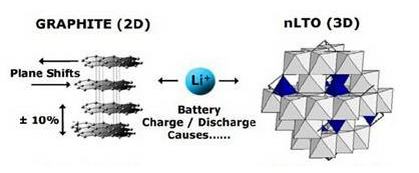It can be known from the news that many new energy vehicles that use lithium titanate batteries as the power source in China have already been put into operation. A number of companies such as Beiqi Foton Motor Co., Ltd., Jinlong United Automotive Industry (Suzhou) Co., Ltd., Xiamen Jinlong Automobile Group Co., Ltd., Anhui Ankai Automobile Co., Ltd. and Zhuhai Yinlong New Energy Co., Ltd. have also launched titanium. New energy bus for lithium acid battery.
The power battery is the energy source of the new energy vehicle, and the performance of the power battery determines the performance of the vehicle. Power batteries include lithium ion batteries, nickel metal hydride batteries, super capacitors, fuel cells, and the like. At present, the main type of power battery used in new energy vehicles is a lithium ion power battery.
The lithium ion power battery is composed of four main parts: a positive electrode, a negative electrode, a separator and an electrolyte. The positive electrode of the lithium ion battery is generally a material having a high potential and reversibly deintercalating lithium ions, such as lithium manganate, lithium iron phosphate, ternary materials and the like. The negative electrode of a lithium ion battery is generally a carbon negative electrode material such as graphite. At present, the research on cathode materials has reached a bottleneck, so the research on anode materials has become another key. Lithium titanate is the leader in the anode material, so we talk about the research and development status of lithium titanate in power batteries.
First, lithium titanate properties
The ideal anode material of the power battery should have the following properties: high charge and discharge efficiency and cycle life; high structural stability, chemical stability and thermal stability; high specific capacity, good safety; abundant resources, low price, relative preparation It is simple and does not pollute the environment.
The current research on anode materials for lithium ion batteries is mainly focused on carbon-based materials. The potential of the carbon electrode after lithium insertion in the battery reaction process is close to the potential of the metal lithium. Once the battery is overcharged, the surface of the carbon electrode is likely to precipitate metallic lithium. The generated metal lithium reacts with the electrolyte to generate a flammable gas, which brings considerable safety hazards to the power battery. In addition, the negative electrode of the graphite material has a problem of co-intercalation with the electrolyte, is highly sensitive to the electrolyte, and has limited stability, which causes the cycle stability of the electrode to be affected. The alloy-based anode material has a higher specific capacity than the carbon anode material, and the repeated insertion and removal of lithium during charging and discharging causes a large change in the volume of the alloy-based anode to cause deterioration in cycle performance. Some properties of graphite and lithium titanate anode materials are shown in the table below.

Lithium titanate, Li4TI5O12, face-centered cubic spinel structure. The commonly used compound has the molecular formula AM2O4, the space group is Fd3m, and the unit cell parameter a=0.836 nm. This spinel structure has a certain accommodation space for lithium ions, and a lithium titanate can accommodate three lithium ions. Lithium ion intercalation and deintercalation during charge and discharge have little effect on the structure of the lithium titanate material because the crystal structure of lithium titanate hardly changes, and the value of a increases only from 0.836 nm to 0.837 nm. This phenomenon is called "zero strain", so lithium titanate is also called "zero strain material." This property plays an important role in the electrode material, and can avoid structural changes due to the expansion and contraction of the material during charging and discharging, thereby improving the performance of the electrode and reducing the large attenuation of the specific capacity, thereby prolonging the service life of the battery. .

The chemical diffusion coefficient of lithium titanate (generally 2 & TImes; 10-8 cm2 / s) is larger than the diffusion coefficient of the carbon negative material - an order of magnitude, and the high diffusion coefficient means that lithium titanate is faster than other carbon negative materials. More cycle charge and discharge capacity. However, lithium titanate itself does not provide a lithium source, so it can only be used with lithium-containing electrode materials. When lithium titanate is used as the positive electrode, the negative electrode can only be metallic lithium or lithium alloy. At this time, the voltage of the battery is about 1.5V. Lithium titanate can be used as a negative electrode and a positive electrode material such as LiCoO2 or LiMn2O4 to form a battery having a voltage of 3V or higher. Although lithium titanate can be used as a positive electrode as a positive electrode, since the potential of Li+/Li is 1.5 V, research and application as a positive electrode material are not many. The spinel structure has a three-dimensional lithium ion diffusion channel, so lithium titanate also performs well in high and low temperature performance.
The high potential (1.5 V vs Li+/Li) of lithium titanate means that the SEI film which is usually produced on the surface of the carbon negative electrode in contact with the electrolyte is hardly formed on the surface of the lithium titanate as compared with the carbon negative electrode material. It is also difficult to form lithium dendrites on the surface of lithium titanate in the normal voltage range. This is important because the possibility of lithium dendrites causing a short circuit inside the battery is largely avoided. Therefore, the safety of a lithium ion battery using lithium titanate as a negative electrode is relatively high in various types of lithium ion batteries.
Second, application and progress
The application of lithium titanate power batteries in the market is mainly based on new energy buses and buses, in addition to the application in the energy storage market and related industries. At present, there are not many enterprises that can mass produce lithium titanate batteries. The international representative is Toshiba and Altairnano in Japan, and Huzhou Weihong is represented in China.
The SCiB super lithium battery developed by Toshiba of Japan, that is, the high-power lithium titanate lithium-ion battery, has a capacity of less than 10% after charging and discharging cycles of 3000 times under rapid charge and discharge conditions. Fast charging with a certain high current can fill more than 90% of capacity in 5 minutes. And with excellent low-temperature discharge performance, the battery can still discharge more than 80% of the capacity at minus 30 °C. SCiB batteries have the advantages of fast charging and long life, mainly used in electric motorcycles, electric vehicles and car start-stop batteries.

The lithium titanate power battery for 5Ah hybrid vehicle developed by Ener Del Company of the United States uses spinel lithium manganate material for the positive electrode. Continuous discharge at 50C rate can discharge more than 95% of the battery capacity, while the battery temperature is less than 35 °C. In an environment of minus 30 ° C, discharge at a rate of 1 C can still release more than 90% of the capacity. At a high temperature of 55 ° C, even if 1000 times of 100% DOD charge and discharge cycle was performed at 5 C, the capacity was maintained at 95% or more, and excellent cycle life performance was exhibited.
Altairnano USA has its unique core technology on lithium titanate batteries. The developed 10Ah high-power lithium battery uses lithium cobaltate as the positive electrode, and the 100% DOD charge and discharge cycle life at 10C is as high as 20,000 times or more. The excellent low-temperature discharge performance allows the battery to discharge more than 60% at a low temperature of minus 40 °C. The battery has high thermal stability and does not emit smoke or fire explosion even after being left at a high temperature of 240 ° C for 30 minutes. The hybrid electric bus provided for California in the United States has been in operation since 2008, and its fuel economy index is much higher than that of ordinary diesel generators.
In recent years, the domestic lithium titanate battery technology and performance is not much different from foreign countries, lithium titanate battery has been localized and gradually used in the field of new energy vehicles. The domestic enterprises capable of producing lithium titanate batteries mainly include Huzhou Weihong Power Co., Ltd., CITIC Guoan Mengli Power Technology Co., Ltd., Zhuhai Yinlong New Energy Co., Ltd., Tianjin Jiewei Power Industry Co., Ltd., etc. Fast-filled pure electric bus, plug-in hybrid bus, etc.
The lithium titanate battery successfully developed by Anhui Tiankang Group New Energy Co., Ltd. passed the inspection side of the relevant inspection center. The results show that the lithium titanate battery has good high and low temperature resistance, and the charge and discharge energy conversion efficiency can reach more than 90%. Performance and cycle life are at an advanced level. The general lithium-ion battery has a charge and discharge cycle life of about 5,000 cycles, and the battery cycle life can reach more than 20,000 times.
Huzhou Weihong has been committed to the development of lithium titanate technology, with a capacity of 80,000 10Ah lithium titanate battery products. As of the end of 2014, Huzhou Weihong's 10min fast-charging battery system has been equipped with more than 3,000 hybrid electric buses, mainly exported to foreign countries and Chongqing, China.
The lithium titanate battery produced by Hebei Yinlong has two types of soft pack batteries and cylindrical batteries. The battery has a 100% DOD cycle count of more than 16,000 cycles and a 10% DOD of 1.6 million cycles. In terms of power battery applications, the lithium titanate battery used in the new pure electric bus of Yinlong has a cruising range of up to 80km, fast charging takes only 6 to 10 minutes, and it takes only 30 to 60 minutes to use the nighttime slow charging. This model has been adopted in many public transportation systems in Guangdong and Hebei.
Third, look to the future
In general, the main problem of lithium titanate is that the rate performance is poor and the energy density is insufficient. The specific capacity of lithium titanate decays rapidly at high rates. In the practical application of lithium-ion power batteries, high-rate operating characteristics are one of the important factors affecting large-scale commercialization. However, the lithium titanate battery has the advantage of fast charging. With the large coverage of the charging facility, the electric vehicle equipped with the lithium titanate battery can be charged anytime and anywhere, and the requirement for the energy density of the lithium titanate battery will be reduced. Under the current environment of vigorous development of new energy automobile industry, it is necessary for all parties to make efforts to promote the further development and wide application of lithium titanate power battery technology.
This Automation curtain is specially designed for automation industry. SDKELI LSC2 light curtain is designed for automation field, with small size, compact structure and strong anti-interference ability, and the product meets IEC 61496-2 standards. The Automatic Light Curtain is with reliable quality and very competitive price. It has been used in many factories and has replaced curtains from Sick, Omron, Banner, Keyence, etc.
Automatic Light Curtain,Laser Light Curtain,Automation Light Beam Sensor,Automatic Infrared Beam Sensor,Infrared Beam Curttain Sensor,Infrared Beam Sensor
Jining KeLi Photoelectronic Industrial Co.,Ltd , https://www.sdkelien.com